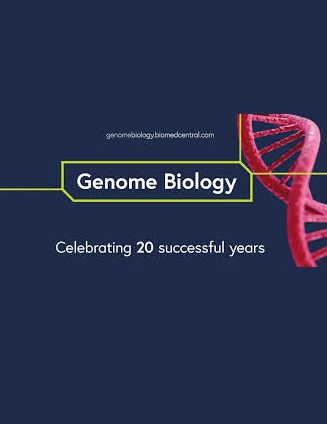A new IDH-independent hypermethylation phenotype is associated with astrocyte-like cell state in glioblastoma
IF 10.1
1区 生物学
Q1 BIOTECHNOLOGY & APPLIED MICROBIOLOGY
引用次数: 0
Abstract
DNA methylation plays a crucial role in cancer development and progression and has been linked to genetically and clinically distinct tumor classes, including IDH-mutated and IDH-wildtype adult-type diffuse gliomas. Here, we identify a CpG-island methylator phenotype (CIMP) that characterizes the receptor tyrosine kinase 2 (RTK2) subtype of IDH-wildtype glioblastoma. This RTK2-CIMP affects genomic locations and cell functions distinct from those of IDH mutation-associated IDH-CIMP and suppresses the expression of its target genes. The RTK2-CIMP-region chromatin is characterized by a combination of repressive and activating marks, including polycomb-associated H3K27me3 and enhancer-associated H3K4me1, consistent with DNA methylation-mediated silencing of genes with bivalent-state promoters in neural progenitor cells. Functionally, RTK2-CIMP affects neuronal lineage genes and is significantly associated with astrocyte-like glioblastoma, suggesting that RTK2-CIMP is an epigenetic signature of the astrocyte-like cell state. Furthermore, we demonstrate that RTK2-CIMP can be induced by genetic manipulation in glioblastoma cells. Our results suggest that RTK2-CIMP is a key contributor to cell-state plasticity in glioblastoma.胶质母细胞瘤中一种新的非idh依赖性超甲基化表型与星形细胞样细胞状态相关
DNA甲基化在癌症的发生和进展中起着至关重要的作用,并且与遗传和临床不同的肿瘤类别有关,包括idh突变型和idh野生型成人型弥漫性胶质瘤。在这里,我们鉴定了一种cpg岛甲基化表型(CIMP),它表征了idh野生型胶质母细胞瘤的受体酪氨酸激酶2 (RTK2)亚型。这种RTK2-CIMP影响不同于IDH突变相关的IDH- cimp的基因组位置和细胞功能,并抑制其靶基因的表达。rtk2 - cimp区域染色质的特征是抑制和激活标记的组合,包括polycomb相关的H3K27me3和增强子相关的H3K4me1,这与神经祖细胞中DNA甲基化介导的二价态启动子基因沉默一致。功能上,RTK2-CIMP影响神经元谱系基因,并与星形细胞样胶质母细胞瘤显著相关,提示RTK2-CIMP是星形细胞样细胞状态的表观遗传标志。此外,我们证明RTK2-CIMP可以通过基因操作在胶质母细胞瘤细胞中诱导。我们的研究结果表明RTK2-CIMP是胶质母细胞瘤细胞状态可塑性的关键贡献者。
本文章由计算机程序翻译,如有差异,请以英文原文为准。
求助全文
约1分钟内获得全文
求助全文
来源期刊

Genome Biology
Biochemistry, Genetics and Molecular Biology-Genetics
CiteScore
21.00
自引率
3.30%
发文量
241
审稿时长
2 months
期刊介绍:
Genome Biology stands as a premier platform for exceptional research across all domains of biology and biomedicine, explored through a genomic and post-genomic lens.
With an impressive impact factor of 12.3 (2022),* the journal secures its position as the 3rd-ranked research journal in the Genetics and Heredity category and the 2nd-ranked research journal in the Biotechnology and Applied Microbiology category by Thomson Reuters. Notably, Genome Biology holds the distinction of being the highest-ranked open-access journal in this category.
Our dedicated team of highly trained in-house Editors collaborates closely with our esteemed Editorial Board of international experts, ensuring the journal remains on the forefront of scientific advances and community standards. Regular engagement with researchers at conferences and institute visits underscores our commitment to staying abreast of the latest developments in the field.
 求助内容:
求助内容: 应助结果提醒方式:
应助结果提醒方式:


